It is important that security risks are considered early and in conjunction with the production safety risk assessment.
The ΒιΆΉΤΌΕΔβs worldwide brand and reputation make it a popular target for those who seek to curtail its broadcasting output and prevent stories or issues receiving fair and balanced coverage.
What Can Go Wrong?
- Attacks or threats to the safety of employees and contractors, when working for the ΒιΆΉΤΌΕΔ, particularly when deployed away from their usual base in the UK or overseas. This might include reputational or personal abuse, rendered verbally, through social media or internet websites; physical violence, capture, imprisonment and stalking.
- Attacks or threats to the ΒιΆΉΤΌΕΔ, its contractors and other members of the press.
- Physical, electronic or cyber-based attacks on ΒιΆΉΤΌΕΔ buildings, technical infrastructure, production teams and locations, programme output, transmission paths and communications, including phones and IT systems.
Legal/ΒιΆΉΤΌΕΔ Requirements
- This guide provides important background and information to inform your planning, assessment and arrangements. Reading them does not make you an expert, nor preclude the need for separate risk assessment. If you require any additional information or clarification you should always contact the Safety Advice Line or High Risk team, as appropriate.
Control Measures
General Controls
- It is important to plan ahead rather than be driven by unfolding events:
- Identify the members of a crisis management team in the planning phase
- Establish a protocol for passing routine information and an escalation procedure. This should include weekends and βout of hoursβ provision.
1 - Planning
Identify potential crisis management team members before work starts. For example:
- Person in charge of production and a responsible manager
- Corporate Security or High Risk Team representative
- HR representative
- The ΒιΆΉΤΌΕΔ Press Office should be consulted
- A legal advisor may be required
- Ensure HR and contact information is up to date and checked, including contact numbers for nominated Next of Kin.
ΒιΆΉΤΌΕΔ Corporate Security and the High Risk Team can support the planning process and contribute to the development of risk assessments by;
- Advising on appropriate training in preparation for an assignment
- Advising on the crisis management arrangements.
2- Managing Risks
Where there are significant risks identified, or there is any concern for the safety and security of staff or contributors ΒιΆΉΤΌΕΔ Safety must be consulted:
- Where there is criminal threat, activity or intent, inform ΒιΆΉΤΌΕΔ Corporate Security at the earliest opportunity. They are responsible for advising on the safety and security of staff after production and transmission.
- For work in Hostile Environments, High Risk Activities and High Risk Events contact the ΒιΆΉΤΌΕΔ High Risk Team.
- In a ΒιΆΉΤΌΕΔ location, ensure personnel remain vigilant to security risks, wear ΒιΆΉΤΌΕΔ ID and do not let people "tailgate" into secure areas.
- If your assessment indicates that the team or individuals are likely to be involved in traumatic events or situations, consider Trauma Awareness training. More information can be found in the Trauma guide.
3 - Managing an Incident or Event
- In the event of a fatality or serious injury notify senior management, nominated next of kin, HR and Press Office. Read the HR Support during Major incidents document for more information.
- If necessary plan to recover staff and provide appropriate managerial, welfare and trauma support, for those impacted by events.
- Once the initial emergency phase has passed the following information should be established
Establish the facts/chronology of the incident as far as possible:
- Establish the follow up to the incident by local emergency services and ΒιΆΉΤΌΕΔ bureau/office if appropriate. Overseas legislation may differ from UK regulations.
- Did the individual act on their own initiative?
- Did the individual respond to direction from ΒιΆΉΤΌΕΔ management?
- Was the individual directed by an independent company?
- Terms of Contract: What contract or terms of service was the individual working under?
- Were there special circumstances such as a leave of absence from a ΒιΆΉΤΌΕΔ post?
- If working as a stringer did the individual offer copy to the ΒιΆΉΤΌΕΔ or were they contracted for a specific piece of work?
- Was there a recent history of copy/pieces supplied?
- Risk Assessment Process: Was there a Risk Assessment in place and were controls or work procedures being followed?
- Confirm the identity of the authority for sign off and provision of safety and/or specialist advice
- Was individual appropriately trained and suitably equipped?
4 - Points of Contact
For Programme related issues, contact is through:
- W1 Duty Manager.
- News Duty Operations Manager (News DOM)
- ΒιΆΉΤΌΕΔ Corporate Security
- ΒιΆΉΤΌΕΔ High Risk Team
Division Specific Issues
- No division specific issues.
FAQs/Did You Know?
The latest ΒιΆΉΤΌΕΔ emergency information and incident updates can be found from the ΒιΆΉΤΌΕΔ emergency information web page and using the sources below:
- Telephone: 0800 0688 159
- Twitter: @ΒιΆΉΤΌΕΔ159
Recommended links
- [ΒιΆΉΤΌΕΔ network only]
- [ΒιΆΉΤΌΕΔ network only]
High Risk topics
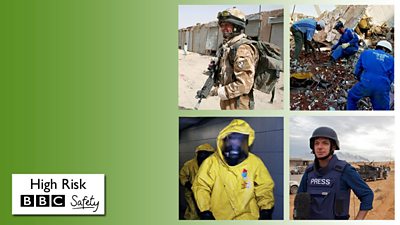
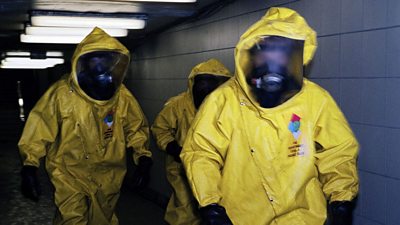 CBRN and Industrial SpillsA guide to chemical, biological and radiation related hazards.
CBRN and Industrial SpillsA guide to chemical, biological and radiation related hazards.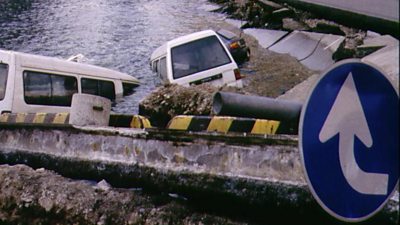 Crisis Management and Security SupportThe ΒιΆΉΤΌΕΔ and its contractors are sometimes required to work in difficult and challenging circumstances. Safety and security issues may occur either during programme making or following transmission.
Crisis Management and Security SupportThe ΒιΆΉΤΌΕΔ and its contractors are sometimes required to work in difficult and challenging circumstances. Safety and security issues may occur either during programme making or following transmission. Disaster CoverageThis information should be used during an initial response to a disaster and may be superseded by a specific risk assessment.
Disaster CoverageThis information should be used during an initial response to a disaster and may be superseded by a specific risk assessment.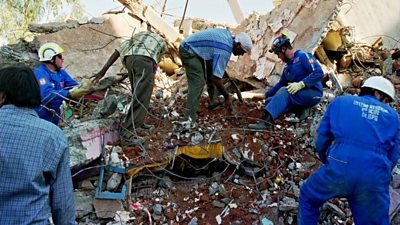 Disaster Coverage β Health AspectsA guide to the particular health risks when visiting areas subject to natural or man-made disasters.
Disaster Coverage β Health AspectsA guide to the particular health risks when visiting areas subject to natural or man-made disasters.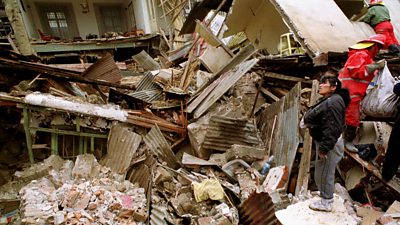 EarthquakesThis Guide helps you decide how to manage risks in the event of an earthquake. It applies to those living and working in an earthquake area on how to prepare, as well as to journalists covering the aftermath of an earthquake.
EarthquakesThis Guide helps you decide how to manage risks in the event of an earthquake. It applies to those living and working in an earthquake area on how to prepare, as well as to journalists covering the aftermath of an earthquake. [ΒιΆΉΤΌΕΔ Network only] PTK Destinations, the ΒιΆΉΤΌΕΔ's Hostile Environment Country site is the best way to plan and manage risk for ΒιΆΉΤΌΕΔ productions.
[ΒιΆΉΤΌΕΔ Network only] PTK Destinations, the ΒιΆΉΤΌΕΔ's Hostile Environment Country site is the best way to plan and manage risk for ΒιΆΉΤΌΕΔ productions.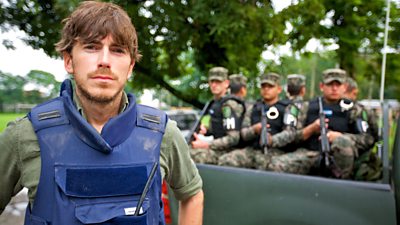 Security on LocationThis Security Guideline provides measures to help mitigate the security threats associated with production activities on location, including door-stepping, covert filming, working with crowds and public order issues.
Security on LocationThis Security Guideline provides measures to help mitigate the security threats associated with production activities on location, including door-stepping, covert filming, working with crowds and public order issues. Terrorist Bomb IncidentsA Guideline for staff covering stories on terrorist bomb threats on location, or at the site of an unexploded bomb (UXB). It could also be of relevance at the site of an industrial explosion.
Terrorist Bomb IncidentsA Guideline for staff covering stories on terrorist bomb threats on location, or at the site of an unexploded bomb (UXB). It could also be of relevance at the site of an industrial explosion.
More from SSR
- Your platform to record accidents, risk assessments, assurance monitoring and inspections
- Safety Equipment StoresJust one number to call: 0844 800 8875
- ΒιΆΉΤΌΕΔ Safety GuidelinesAn A-Z of ΒιΆΉΤΌΕΔ's Health and Safety Guidelines
- Safety Advice Line: 0370 411 0464 Email: safety@bbc.co.uk
- A-Z of ΒιΆΉΤΌΕΔ Safety Guidelines
- Accident Reporting and Investigation
- ΒιΆΉΤΌΕΔ Health & Safety Policy
- Contractors (incl. vetted lists)
- Contributors
- Fire Safety
- Freelancers
- Independent Production Companies
- Risk Assessment
- Safety Alerts
- Safety Responsibilities
- Safety Training
- Sets & Premises Safety Guide
Events guidance - key links:
- Exhibitions
- General Guidance
- Indoor Location Recce Checklist
- Outdoor Location Recce Checklist
- Major Incidents & Emergency Planning
- Marketing and Promotional
- Noise Exposure
- Planning and Management
- Responsibilities
- Responsibilities Form
- Laser Lighting Effects
- Strobe Lighting
- Temporary Stages and Rostra
Health topics - key links:
- (ΒιΆΉΤΌΕΔ network only)
- Contributors Fitness to Participate
- Display Screen Equipment (DSE)
- (ΒιΆΉΤΌΕΔ network only)
- First Aid and Welfare on Location
- International Travel - Risks & Health
- Manual Handling
- Mental Health: ΒιΆΉΤΌΕΔpage
- (ΒιΆΉΤΌΕΔ network only)
- Personal Health and Wellbeing
- Pregnancy
- Psychological Trauma Support & Trauma Risk Management (TRiM)
- Tiredness and Fatigue
- Travel Health Contacts
ΒιΆΉΤΌΕΔ High Risk - key links:
- CBRN and Industrial Spills
- Covert Filming
- Crisis Management and Security Support
- Demonstrations, Protests and Crowds
- Disaster Coverage
- Door Stepping
- (ΒιΆΉΤΌΕΔ network only)
- (ΒιΆΉΤΌΕΔ network only)
- Public Order
- Safety Equipment Stores
ΒιΆΉΤΌΕΔ Journalism - key links:
ΒιΆΉΤΌΕΔ Productions - key links:
- Aerial Filming and Airfields
- Animals: Displaying and handling for performance
- Boats: Working on
- Children and Young People
- Driving
- Electrical Equipment and Systems
- First Aid and Welfare on Location
- Food Safety (Cooking and Catering)
- Remote Location Working
- Roads and Streets: Working by
- Security of Productions on Location
- Stunts
- Tiredness and Fatigue
- Unmanned Aerial Systems (UAS aka Drones)
- Vehicles: Recording in, from and around
- Working at Height: Mobile Elevating Work Platforms
- Working at Height: Tower Scaffolds
- (ΒιΆΉΤΌΕΔ Network only)
ΒιΆΉΤΌΕΔ Security - key links:
ΒιΆΉΤΌΕΔ Sport - key links:
About this site
This site describes what the ΒιΆΉΤΌΕΔ does in relation to managing its health, safety and security risks and is intended for those who work directly for the ΒιΆΉΤΌΕΔ.
It is not intended to provide instruction or guidance on how third parties should manage their risks. The ΒιΆΉΤΌΕΔ cannot be held liable for how this information is interpreted or used by third parties, nor provide any assurance that adopting it would provide any measure of legal compliance. More information
Some links on this site are only accessible when connected to the ΒιΆΉΤΌΕΔ network
